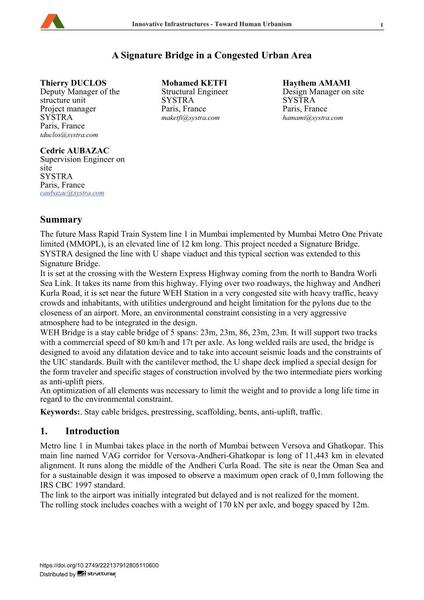A Signature Bridge in a Congested Urban Area

|
|
|||||||||||
Bibliographic Details
| Author(s): |
Thierry Duclos
Mohamed Ketfi Haythem Amami Cedric Aubazac |
||||
|---|---|---|---|---|---|
| Medium: | conference paper | ||||
| Language(s): | English | ||||
| Conference: | 18th IABSE Congress: Innovative Infrastructures – Towards Human Urbanism, Seoul, Korea, 19-21 September 2012 | ||||
| Published in: | IABSE Congress Seoul 2012 | ||||
|
|||||
| Page(s): | 357-364 | ||||
| Total no. of pages: | 8 | ||||
| DOI: | 10.2749/222137912805110600 | ||||
| Abstract: |
The future Mass Rapid Train System line 1 in Mumbai implemented by Mumbai Metro One Private limited (MMOPL), is an elevated line of 12 km long. This project needed a Signature Bridge. SYSTRA designed the line with U shape viaduct and this typical section was extended to this Signature Bridge. It is set at the crossing with the Western Express Highway coming from the north to Bandra Worli Sea Link. It takes its name from this highway. Flying over two roadways, the highway and Andheri Kurla Road, it is set near the future WEH Station in a very congested site with heavy traffic, heavy crowds and inhabitants, with utilities underground and height limitation for the pylons due to the closeness of an airport. More, an environmental constraint consisting in a very aggressive atmosphere had to be integrated in the design. WEH Bridge is a stay cable bridge of 5 spans: 23m, 23m, 86, 23m, 23m. It will support two tracks with a commercial speed of 80 km/h and 17t per axle. As long welded rails are used, the bridge is designed to avoid any dilatation device and to take into account seismic loads and the constraints of the UIC standards. Built with the cantilever method, the U shape deck implied a special design for the form traveler and specific stages of construction involved by the two intermediate piers working as anti-uplift piers. An optimization of all elements was necessary to limit the weight and to provide a long life time in regard to the environmental constraint. |
||||
| Keywords: |
cable-stayed bridge scaffolding prestressing traffic bents anti-uplift
|
||||
